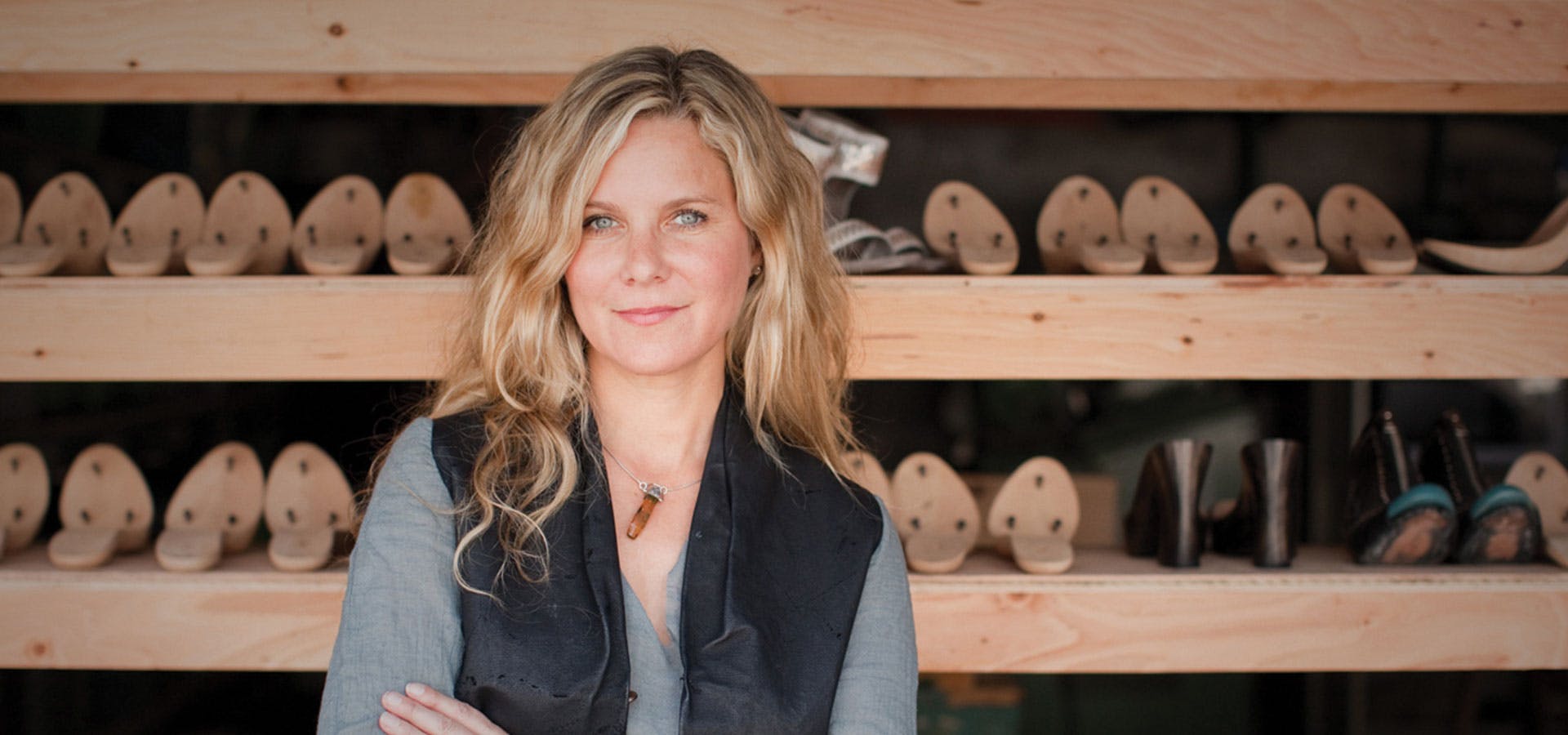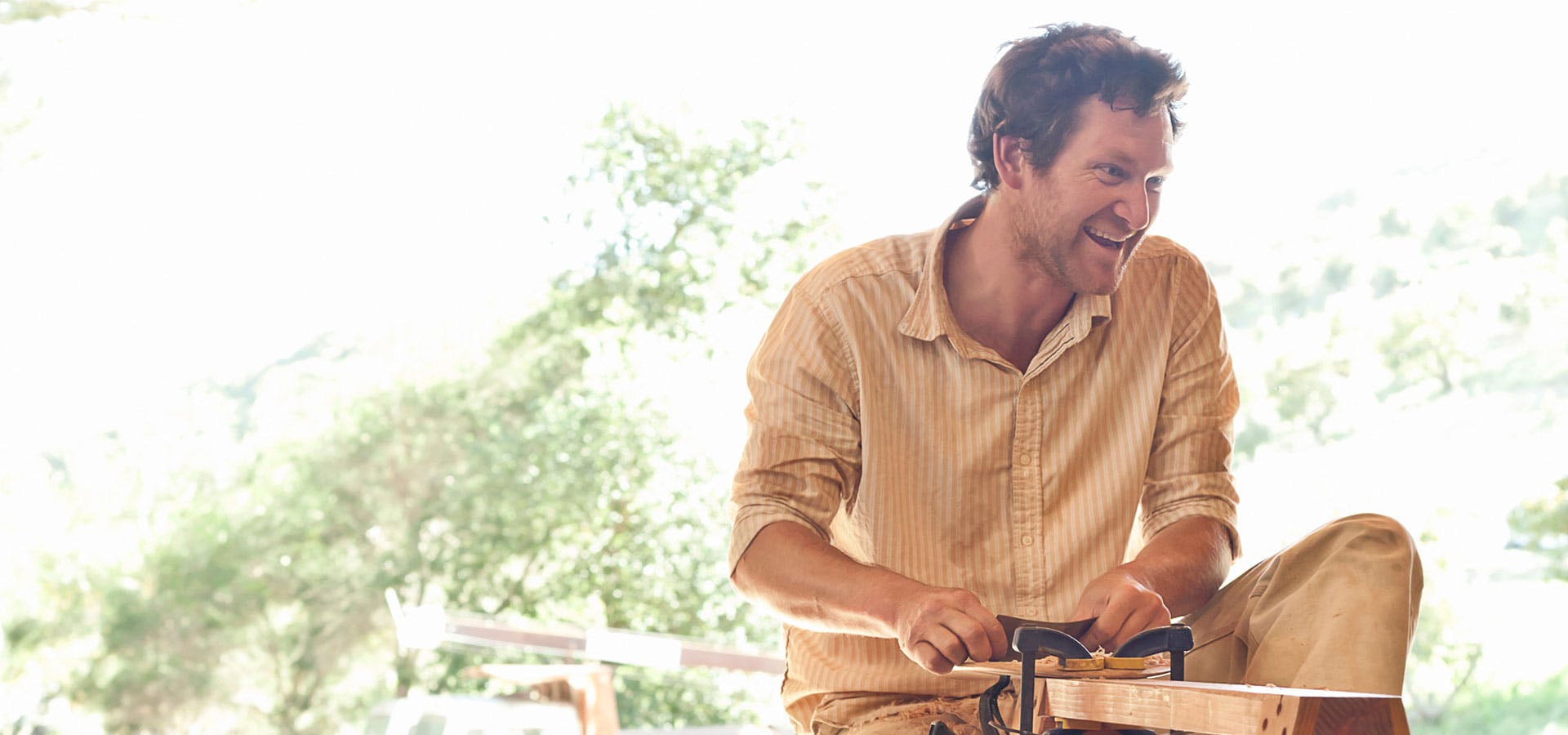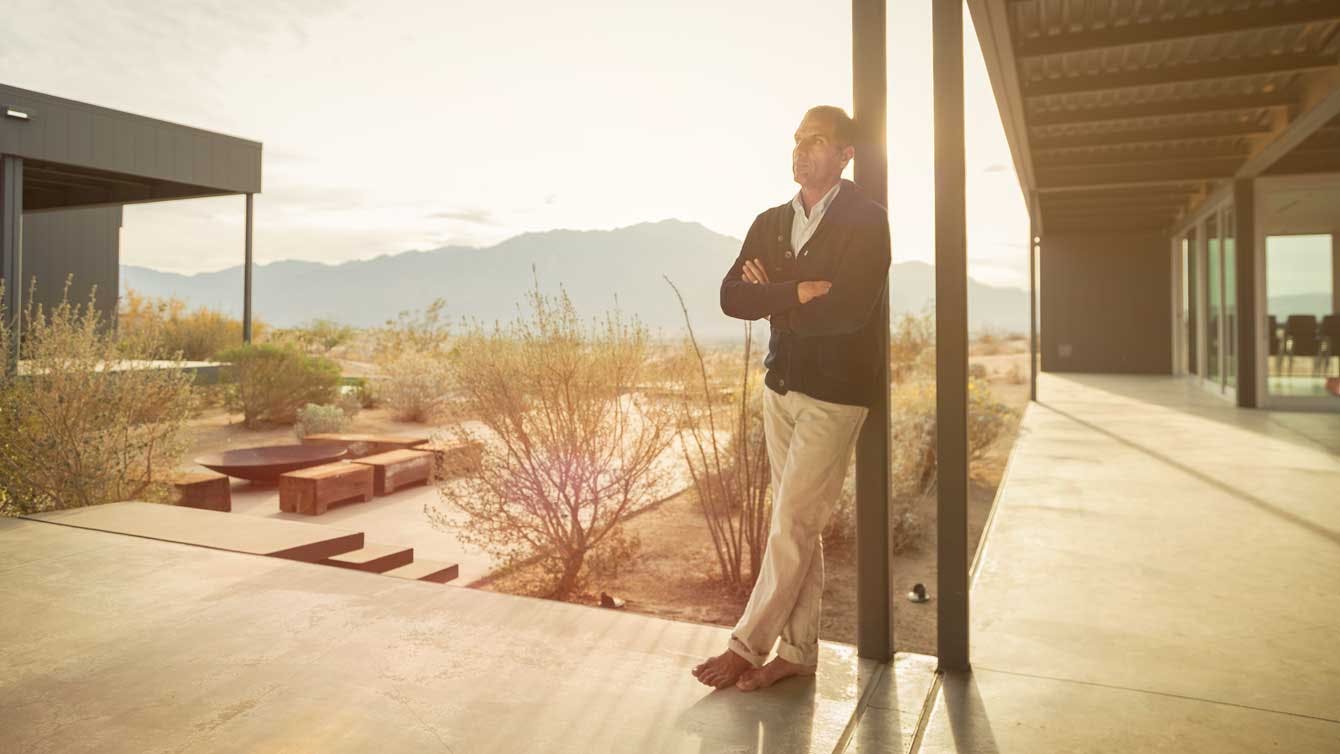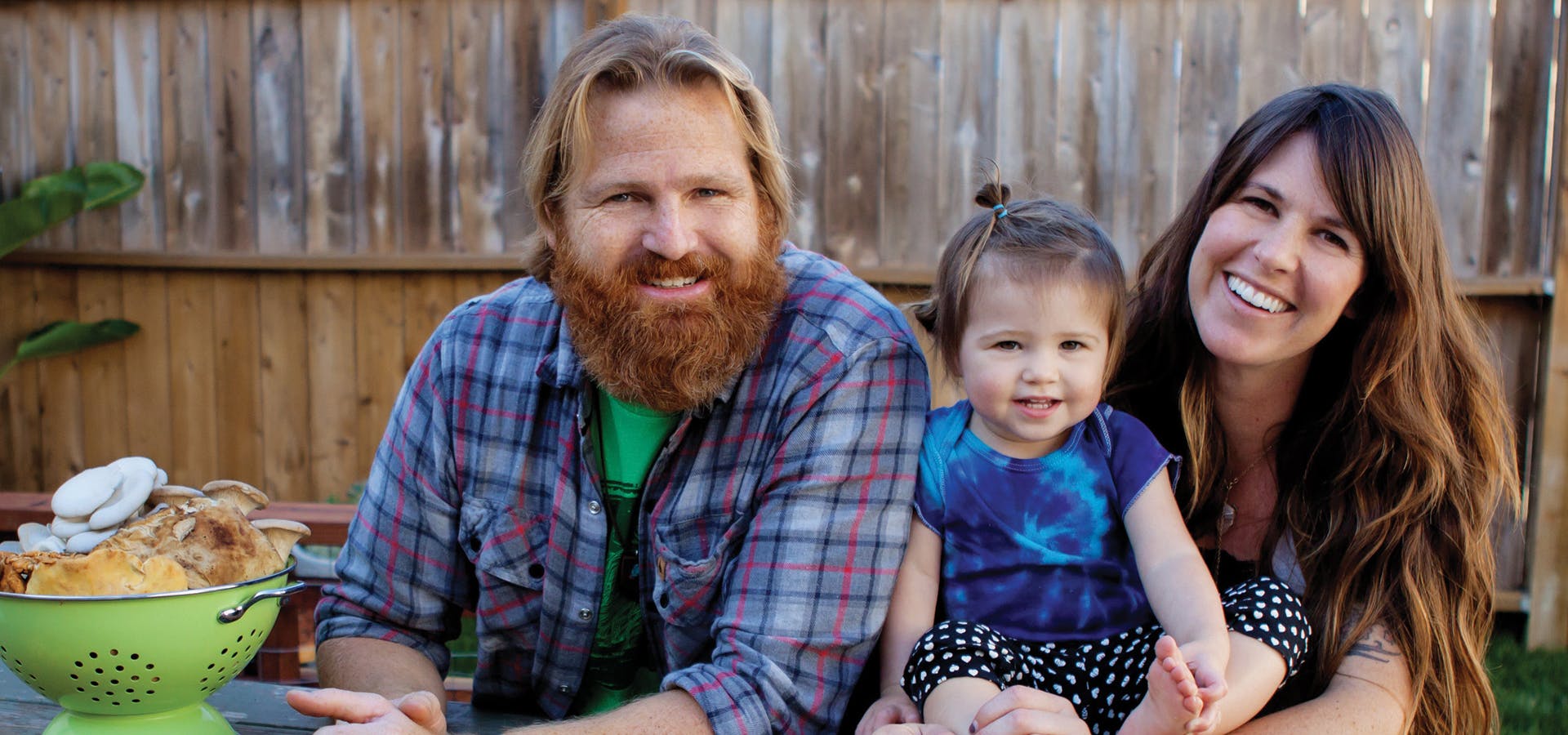Since opening last year, Calleen’s cozy boutique on Ventura Boulevard has become a Studio City fixture, peddling high-end heels, purses, belts and elaborately studded leather accessories to fashion-forward locals. But Calleen’s Valley presence dates back to her beginnings as an independent designer 14 years ago, when she first ventured into a once-thriving industrial neighborhood in North Hollywood’s upper reaches to revive the bygone art of handcrafting shoes.
Today her trendsetting designs and A-to-Z domestic production are points of pride for the unflappable creator. “We do it all under one roof,” she explains on a recent afternoon, as the co-mingling scents of leather and glue waft through the spacious warehouse. “We do everything the old-school way.”
Calleen started small, at first running her business at her Laurel Canyon home. Yet even as her label has grown—the line is now sold in boutiques around the world, and Calleen recently upgraded to a 10,000 square-foot factory (her largest yet)—the operation has retained a personal ambience, thanks to her longtime staff and hands-on approach. Her M.O. is embodied in a banner that hangs high on a cinderblock wall in the main workroom: “Calleen Cordero–Handcrafted in Los Angeles.”
Calleen’s shoe obsession started young. Growing up in Marin County, she would often pass the time in her local footwear store while her mother went shopping, trying on every shoe on display. “I had this crazy passion for shoes,” she recalls. To fund her “fierce desire,” she got a job in the stockroom of an upscale shoe store, Ground Level, at age 15.

Eventually, work trumped school. She attended high school part-time in the mornings and headed to work after lunch. In time, she worked her way up to become the store’s top salesperson. By age 16, Calleen had made such an impression on the store’s owner that she began taking Calleen to Europe on buying trips.
At 18, Calleen became Ground Level’s manager. The enterprising teen also snagged a gig as a freelance merchandiser for Esprit de Corp. when the popular clothing company launched its shoe division.
“They’d get in 300 designs in a season. They hired me, at 16, to come in and go, ‘I like that, I like that, I don’t like that,’” Calleen shares. “That was a nice part of my education.”
It was also a game-changer for Calleen. From that point on, she built a staggering résumé as something of a shoe-whisperer for a string of dominant brands. After moving to LA, she worked for Fred Segal and was then hired to revitalize the struggling Vogue Shoe Co., one of the city’s last shoe manufacturers, in 1990.
“Everybody was going to China and overseas, and the domestic shoe business was leaving, one after another,” she says. As the company struggled to stay afloat, Calleen got her first taste of designing in-house at a shoe factory. “That, I really loved,” she recalls. “I was like, ‘Hey, I can actually do this.’”

Over the next few years, Calleen did everything from launching Kenneth Cole’s men’s shoe division to helping launch Dr. Martens in the U.S. to working for Steve Madden. But by then, she was a single mother raising two sons, and she felt the urge to strike out on her own.
“I realized I was selling my soul. I thought, ‘I can’t work corporate anymore,’” she recalls. “After many prayers to the universe, I finally left.”
Her epiphany came when she stumbled upon a vintage studded belt at a shop on 3rd Street. “I thought it was the coolest thing ever,” she shares, and her fashion instincts kicked into overdrive. “I never even put it on. I was like, ‘It belongs on a shoe.’ Finally, I was like, ‘That’s it!’ I knew it would be my niche market.”
With nothing but a few rough concepts and a dose of determination, Calleen set about trying to make her first pair of shoes. Immediately she went to North Hollywood. She knew the factory-lined Valley pocket was once a hotspot for sculpted wood heels, and she had an inkling that a few small manufacturers remained.
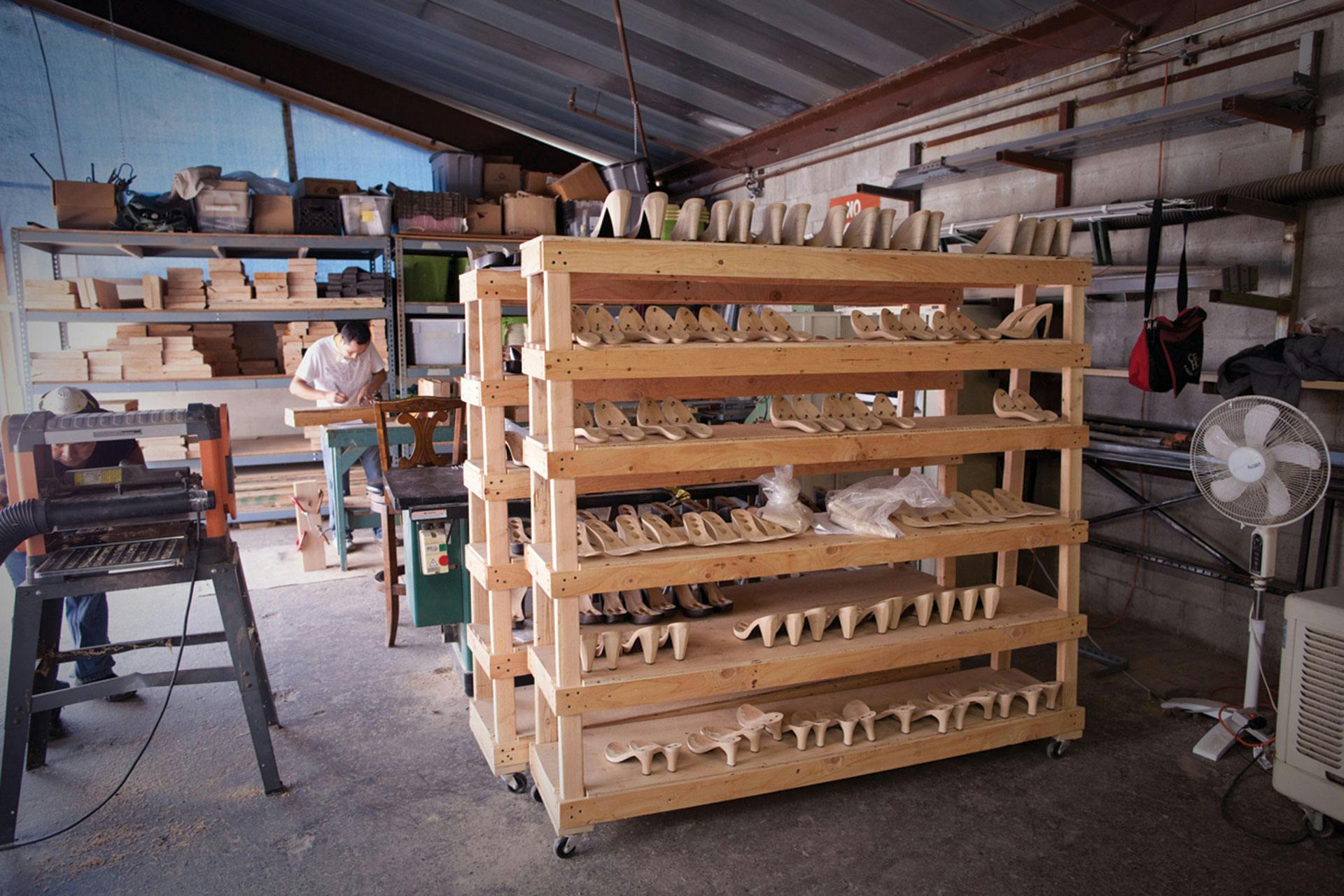
“Back in its heyday, North Hollywood was the shoe capitol for sculpted woods,” she recalls. “Even though the whole industry was kind of dead, there were still some leftover people that knew how to make shoes out here.”
She spent several months knocking on doors, trying to track down craftspeople who would lend their muscle. But without any formal training to speak of, no one would take her seriously. Finally she found a former wood sculptor who agreed to help. “I basically just pulled up a chair behind his desk and we started creating,” she recalls.
In short order, Calleen had three prototypes completed, all early takes on what has become her trademark look: leather sandals festooned with metal studs and rhinestones. She took her first three styles to Madison in Beverly Hills and sold them all. “I was like, ‘Okay, I’m in business!’” she recalls.
In 2000, she quit her day job and launched her collection. At first, Calleen kept track of orders and shipping from her garage, and her first office was in her basement. “You had to be under 5-foot-5 to work in there,” she laughs.
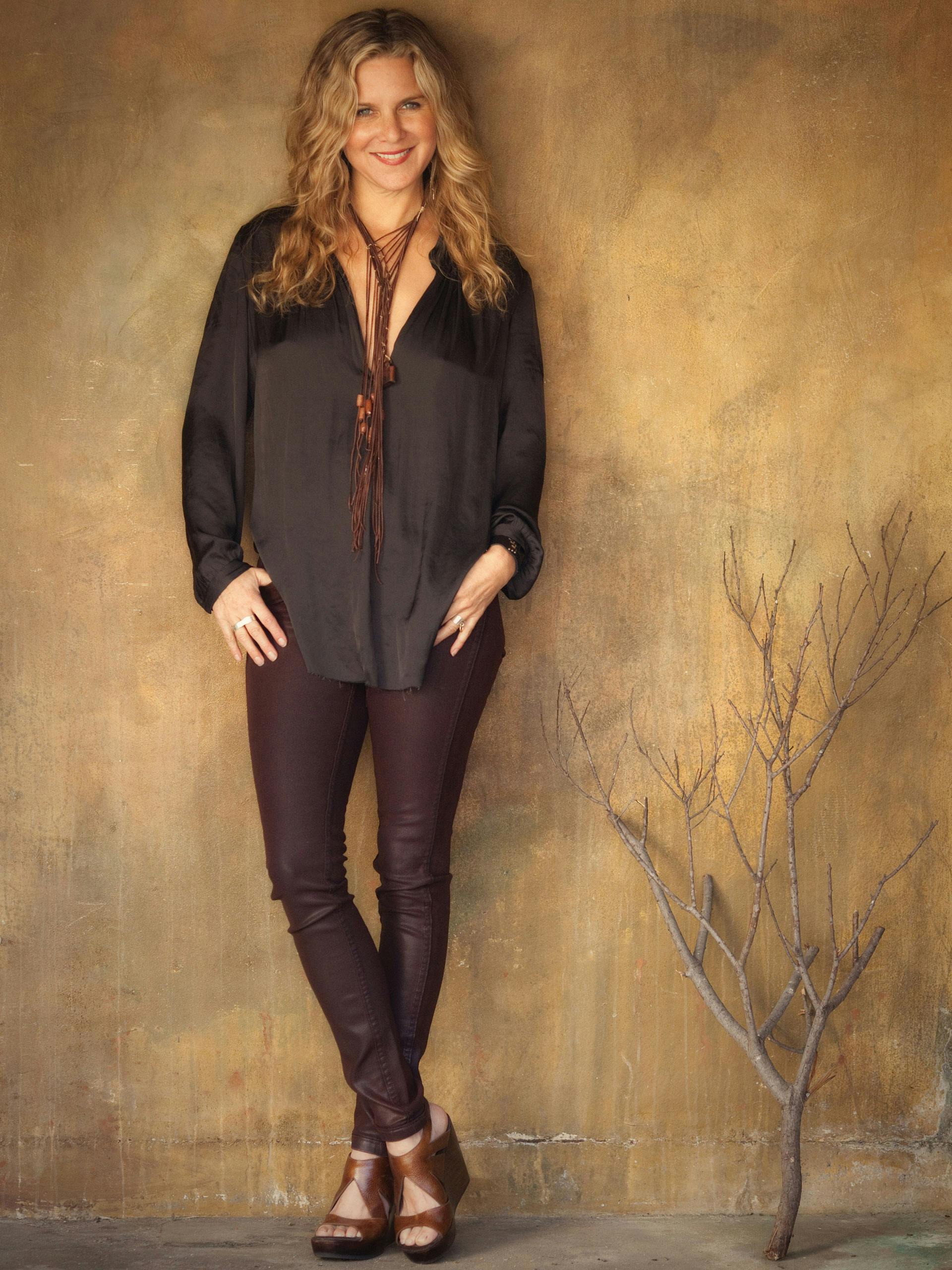
From day one, the line was a hit with consumers. “People had never seen anything like my shoes,” Calleen says. The high-end market was mostly single-sole dress shoes at the time, she recalls, “and I come on the scene with rhinestones and wedges and turquoise on shoes. It was casual/chic. People went bananas for the collection.”
But despite her company’s meteoric rise, Calleen’s business savvy was still weak. After a few years of breakneck growth, she became overwhelmed. “The house was breaking down,” she says, recalling lost orders and angry clients. “I grew so fast, and I just couldn’t handle it.”
So in 2007, she decided to scale back. She let managers go and took time to think smarter about her client base and production process. “I really needed to mature and grow up and start having guidelines. I needed to start being the leader,” she says.
Now Calleen abides by the wisdom of slow and steady. Last year, the company opened two new signature boutiques—in West Hollywood and Studio City—where she hopes to connect personally with the kind of shoppers she designs her collection for. “I’m really a Valley girl,” she admits with a grin. “My lifestyle is more Valley than Hollywood.” When she found her current space for rent on Ventura Boulevard near Coldwater Canyon, “I knew in my bones that’s where I should be.”

Calleen’s two amiable dogs follow her around as she tours her factory’s wood studio, where the air vibrates with the roar of machines. The techniques she scoured North Hollywood for years ago are in daily use.
Most of the wedges and chunky wooden heels start life as planks of alder wood, sourced from sustainable forests. Woodworkers wearing face masks carve each heel by hand and sand it into a smooth, symmetrical form.
Freehand-shaping requires equal measures of artistic intuition and concentration, which creases one worker’s forehead as he guides a heel against a buzzing sanding machine, sending flecks of fine sawdust into the air. Heels are then buffed and triple-waxed “so it looks like fine furniture,” Calleen quips.
“Nothing is done by computer,” she adds. “This is all a lost art.”
Inside, 50 employees work at long tables strewn with leather components, tools and jugs of paint and dye. In the leather room, richly hued bolts of leather are stacked on every shelf. Leather is the only item Calleen imports; most is from Italy, but some is also domestic.
Workers measure, trace and cut the patterns for shoe uppers, purses and belts by hand over a grid. After each piece of leather is cut, it travels to the art room for embellishment. This is where the metal magic happens; here, skilled employees affix the intricate patterns of metal studs that have become Calleen’s hallmark flourish. They use solid nickel, brass and copper studs, which they patina and oxidize themselves to impart a vintage look.
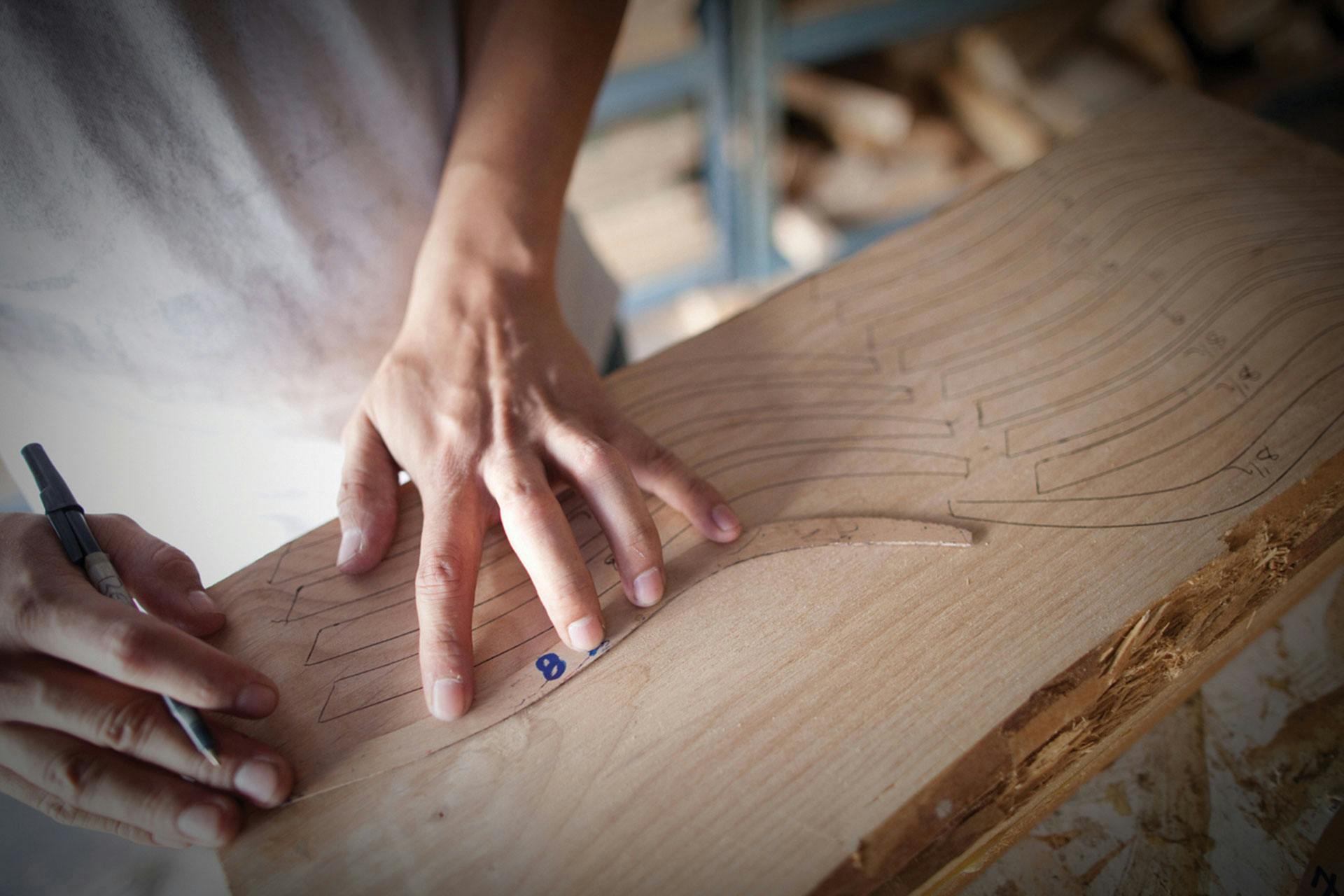
In keeping with Calleen’s handcrafted methodology, workers place every stud by hand and use an old-fashioned kick press to attach them to the leather. It’s a delicate process, and the designer is clearly proud of her crew.
“These guys are amazing,” she says, picking up a swatch of leather adorned with neat rows of studs. “There’s a rhythm; it’s a true craft. When you do this every day for years and years, it’s like second nature.”
Once the uppers are stitched and the soles are finished, each piece is fitted by hand to one of several “lasts”—foot-shaped forms that vary by heel height or toe shape. Here the leather is stretched and molded into a wearable shoe. Calleen designs her own lasts and has them made in Mexico.
When the shoes are completed, they get cleaned, boxed and sent to clients. In all, each shoe passes through about 36 pairs of hands during its creation. “It’s a dream come true being able to manufacture here in Los Angeles,” Calleen says. “I get to come up with an idea and have it made the next day. It’s a designer’s dream.” The downside of domestic production, which accounts for the industry’s move overseas in the first place, is the high overhead cost of manufacturing here. And the handmade nature of her pieces is “so labor intensive” that her company’s profit margin is slimmer than a glance at the price tag might suggest.
Still Calleen plans to stick with her old-world methods. “I really do believe in America,” she says. “I want to keep it here. I like being in control of my own destiny.”
And although celebrities including Julia Roberts, Jennifer Aniston and Eva Mendes have been known to sport her designs, Calleen stays humble with an eye on the past: The first sandals she ever made now sit in a display case near the factory entrance.
“The shoe business has changed so much. It’s all mass-produced; every store looks the same—there’s not a lot of individuality within the collections,” she says. “I want to keep producing shoes that have soul.”
Trendsetting accessory designer Calleen Cordero revives the high art of old-world craftsmanship in her Valley factory and defies the odds as she builds her budding empire.
Calleen Cordero strolls through her North Hollywood factory in a black maxi dress, chatting in a mixture of Spanish and English with the workers. “Is that hard to cut? Mucho tiempo?” she asks one man cutting leather trim. To another, polishing her brand’s signature metal studs in a tumbler, she says, “It works? You notice a difference?”
With her blonde hair tied in a loose ponytail and a pair of—what else?—Calleen Cordero leather sandals on her feet, the petite dynamo exudes a casual air more akin to veteran artisan than corporate exec. Yet at the helm of her eponymous shoe, jewelry and handbag company, she’s both.
 Since opening last year, Calleen’s cozy boutique on Ventura Boulevard has become a Studio City fixture, peddling high-end heels, purses, belts and elaborately-studded leather accessories to fashion-forward locals. But Calleen’s Valley presence dates back to her beginnings as an independent designer 14 years ago, when she first ventured into a once-thriving industrial neighborhood in North Hollywood’s upper reaches to revive the bygone art of handcrafting shoes.
Since opening last year, Calleen’s cozy boutique on Ventura Boulevard has become a Studio City fixture, peddling high-end heels, purses, belts and elaborately-studded leather accessories to fashion-forward locals. But Calleen’s Valley presence dates back to her beginnings as an independent designer 14 years ago, when she first ventured into a once-thriving industrial neighborhood in North Hollywood’s upper reaches to revive the bygone art of handcrafting shoes.
Today her trendsetting designs and A-to-Z domestic production are points of pride for the unflappable creator. “We do it all under one roof,” she explains on a recent afternoon, as the co-mingling scents of leather and glue waft through the spacious warehouse. “We do everything the old-school way.”
Calleen started small, at first running her business at her Laurel Canyon home. Yet even as her label has grown—the line is now sold in boutiques around the world, and Calleen recently upgraded to a 10,000 square-foot factory (her largest yet)—the operation has retained a personal ambience, thanks to her longtime staff and hands-on approach. Her M.O. is embodied in a banner that hangs high on a cinderblock wall in the main workroom: “Calleen Cordero – Handcrafted in Los Angeles.”
Calleen’s shoe obsession started young. Growing up in Marin County, she would often pass the time in her local footwear store while her mother went shopping, trying on every shoe on display.
 “I had this crazy passion for shoes,” she recalls. To fund her “fierce desire,” she got a job in the stockroom of an upscale shoe store, Ground Level, at age 15.
“I had this crazy passion for shoes,” she recalls. To fund her “fierce desire,” she got a job in the stockroom of an upscale shoe store, Ground Level, at age 15.
Eventually, work trumped school. She attended high school part-time in the mornings and headed to work after lunch. In time, she worked her way up to become the store’s top salesperson. By age 16, Calleen had made such an impression on the store’s owner that she began taking Calleen to Europe on buying trips.
At 18, Calleen became Ground Level’s manager. The enterprising teen also snagged a gig as a freelance merchandiser for Esprit de Corp. when the popular clothing company launched its shoe division.
“They’d get in 300 designs in a season. They hired me, at 16, to come in and go, ‘I like that, I like that, I don’t like that,’” Calleen shares. “That was a nice part of my education.”
It was also a game-changer for Calleen. From that point on, she built a staggering résumé as something of a shoe-whisperer for a string of dominant brands. After moving to LA, she worked for Fred Segal and was then hired to revitalize the struggling Vogue Shoe Co., one of the city’s last shoe manufacturers, in 1990.
View Gallery
“Everybody was going to China and overseas, and the domestic shoe business was leaving, one after another,” she says. As the company struggled to stay afloat, Calleen got her first taste of designing in-house at a shoe factory. “That, I really loved,” she recalls. “I was like, ‘Hey, I can actually do this.’”
Over the next few years, Calleen did everything from launching Kenneth Cole’s men’s shoe division to helping launch Dr. Martens in the U.S. to working for Steve Madden. But by then, she was a single mother raising two sons, and she felt the urge to strike out on her own.
 “I realized I was selling my soul. I thought, ‘I can’t work corporate anymore,’” she recalls. “After many prayers to the universe, I finally left.”
“I realized I was selling my soul. I thought, ‘I can’t work corporate anymore,’” she recalls. “After many prayers to the universe, I finally left.”
View Gallery
Her epiphany came when she stumbled upon a vintage studded belt at a shop on 3rd Street. “I thought it was the coolest thing ever,” she shares, and her fashion instincts kicked into overdrive. “I never even put it on. I was like, ‘It belongs on a shoe.’ Finally, I was like, ‘That’s it!’ I knew it would be my niche market.”
With nothing but a few rough concepts and a dose of determination, Calleen set about trying to make her first pair of shoes. Immediately she went to North Hollywood. She knew the factory-lined Valley pocket was once a hotspot for sculpted wood heels, and she had an inkling that a few small manufacturers remained.
“Back in its heyday, North Hollywood was the shoe capitol for sculpted woods,” she recalls. “Even though the whole industry was kind of dead, there were still some leftover people that knew how to make shoes out here.”
She spent several months knocking on doors, trying to track down craftspeople who would lend their muscle. But without any formal training to speak of, no one would take her seriously. Finally she found a former wood sculptor who agreed to help. “I basically just pulled up a chair behind his desk and we started creating,” she recalls.
In short order, Calleen had three prototypes completed, all early takes on what has become her trademark look: leather sandals festooned with metal studs and rhinestones. She took her first three styles to Madison in Beverly Hills and sold them all. “I was like, ‘Okay, I’m in business!’” she recalls.
In 2000, she quit her day job and launched her collection. At first, Calleen kept track of orders and shipping from her garage, and her first office was in her basement. “You had to be under 5-foot-5 to work in there,” she laughs.
From day one, the line was a hit with consumers. “People had never seen anything like my shoes,” Calleen says. The high-end market was mostly single-sole dress shoes at the time, she recalls, “and I come on the scene with rhinestones and wedges and turquoise on shoes. It was casual/chic. People went bananas for the collection.”
But despite her company’s meteoric rise, Calleen’s business savvy was still weak. After a few years of breakneck growth, she became overwhelmed. “The house was breaking down,” she says, recalling lost orders and angry clients. “I grew so fast, and I just couldn’t handle it.”
So in 2007, she decided to scale back. She let managers go and took time to think smarter about her client base and production process. “I really needed to mature and grow up and start having guidelines. I needed to start being the leader,” she says.
Now Calleen abides by the wisdom of slow and steady. Last year, the company opened two new signature boutiques—in West Hollywood and Studio City—where she hopes to connect personally with the kind of shoppers she designs her collection for.
“I’m really a Valley girl,” she admits with a grin. “My lifestyle is more Valley than Hollywood.” When she found her current space for rent on Ventura Boulevard near Coldwater Canyon, “I knew in my bones that’s where I should be.”
 Calleen’s two amiable dogs follow her around as she tours her factory’s wood studio, where the air vibrates with the roar of machines. The techniques she scoured North Hollywood for years ago are in daily use.
Calleen’s two amiable dogs follow her around as she tours her factory’s wood studio, where the air vibrates with the roar of machines. The techniques she scoured North Hollywood for years ago are in daily use.
Most of the wedges and chunky wooden heels start life as planks of alder wood, sourced from sustainable forests. Woodworkers wearing face masks carve each heel by hand and sand it into a smooth, symmetrical form.
View Gallery
Freehand-shaping requires equal measures of artistic intuition and concentration, which creases one worker’s forehead as he guides a heel against a buzzing sanding machine, sending flecks of fine sawdust into the air. Heels are then buffed and triple-waxed “so it looks like fine furniture,” Calleen quips.
“Nothing is done by computer,” she adds. “This is all a lost art.”
Inside, 50 employees work at long tables strewn with leather components, tools and jugs of paint and dye. In the leather room, richly-hued bolts of leather are stacked on every shelf. Leather is the only item Calleen imports; most is from Italy, but some is also domestic.
Workers measure, trace and cut the patterns for shoe uppers, purses and belts by hand over a grid. After each piece of leather is cut, it travels to the art room for embellishment.
This is where the metal magic happens; here, skilled employees affix the intricate patterns of metal studs that have become Calleen’s hallmark flourish. They use solid nickel, brass and copper studs, which they patina and oxidize themselves to impart a vintage look.
In keeping with Calleen’s handcrafted methodology, workers place every stud by hand and use an old-fashioned kick press to attach them to the leather. It’s a delicate process, and the designer is clearly proud of her crew.
 “These guys are amazing,” she says, picking up a swatch of leather adorned with neat rows of studs. “There’s a rhythm; it’s a true craft. When you do this every day for years and years, it’s like second nature.”
“These guys are amazing,” she says, picking up a swatch of leather adorned with neat rows of studs. “There’s a rhythm; it’s a true craft. When you do this every day for years and years, it’s like second nature.”
Once the uppers are stitched and the soles are finished, each piece is fitted by hand to one of several “lasts”—foot-shaped forms that vary by heel height or toe shape. Here the leather is stretched and molded into a wearable shoe. Calleen designs her own lasts and has them made in Mexico.
When the shoes are completed, they get cleaned, boxed and sent to clients. In all, each shoe passes through about 36 pairs of hands during its creation.
“It’s a dream come true being able to manufacture here in Los Angeles,” Calleen says. “I get to come up with an idea and have it made the next day. It’s a designer’s dream.”
The downside of domestic production, which accounts for the industry’s move overseas in the first place, is the high overhead cost of manufacturing here. And the handmade nature of her pieces is “so labor intensive” that her company’s profit margin is slimmer than a glance at the price tag might suggest.
Still Calleen plans to stick with her old-world methods. “I really do believe in America,” she says. “I want to keep it here. I like being in control of my own destiny.”
And although celebrities including Julia Roberts, Jennifer Aniston and Eva Mendes have been known to sport her designs, Calleen stays humble with an eye on the past: The first sandals she ever made now sit in a display case near the factory entrance.
“The shoe business has changed so much. It’s all mass-produced; every store looks the same—there’s not a lot of individuality within the collections,” she says. “I want to keep producing shoes that have soul.”
[tribulant_slideshow gallery_id=”8″]





